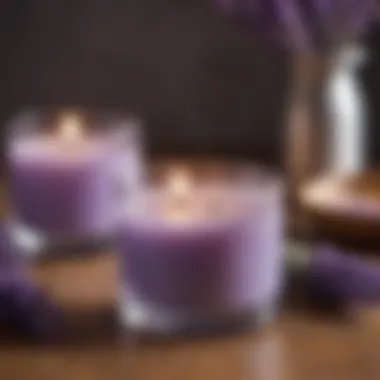Trending Candle Scents: A Comprehensive Exploration


Intro
Candle scents have transcended their functional use, becoming an integral part of our sensory experiences. The delicate interplay of fragrance notes can influence our environments and moods. This article explores the trending candle scents, diving into their sensory appeal and the cultural implications surrounding them. By examining the various fragrance notes, we can understand how these scents are perceived and their connections to mood enhancement.
Furthermore, we will discuss sustainable practices in candle making and how they relate to our desire for a harmonious environment. Trending scents not only fetch attention for their aroma but also serve as a vehicle for personal expression and emotional well-being. Let us embark on this exploration of what these scents offer and how they reflect our collective zeitgeist.
Understanding Candle Scents
Candle scents play a crucial role in shaping our sensory experiences and influencing our emotions. In today’s world, where stress levels are high and the fast pace of life prevails, understanding candle scents becomes not just a matter of preference, but also of well-being. Certain aromas can enhance moods and create a welcoming environment.
The Science Behind Scent
The mechanism of scent perception is quite fascinating. When we inhale an aroma, molecules travel through the nasal cavity to the olfactory bulb, where signals are processed and sent to the brain. This process involves various receptors, each corresponding to specific scent notes.
For example, the fresh, floral notes of jasmine are different from the warm, spicy scent of cinnamon. These intrinsic qualities influence how we perceive them. Profound studies indicate that the brain structures associated with scent perception are closely linked to areas managing emotion and memory. This connection suggests that specific scents can invoke powerful memories or feelings.
Understanding this relationship provides insight into how candles can create desired atmospheres.
How Scents Influence Emotions
The impact of scents on emotions is well documented. The limbic system, responsible for emotional reactions, is heavily involved in how we respond to fragrances.
Research has shown:
- Lavender is known to promote calmness and reduce anxiety.
- Citrus scents like lemon and orange uplift the mood and enhance focus.
- Woody fragrances, such as sandalwood, can create a grounding effect, promoting a sense of serenity.
Each scent has a unique ability to influence our feelings. The careful selection of candle scents can transform a room's energy, making it important to understand one's emotional response to different fragrances.
Cultural Significance of Fragrances
Candle scents also hold cultural importance across various societies. Traditionally, different scents are used in rituals and celebrations, symbolizing connection or purity. For example, in many Western cultures, vanilla is associated with comfort, while in some Eastern traditions, sandalwood is utilized for spiritual cleansing.
Additionally, fragrance preferences can vary widely among cultures, as cultural backgrounds influence perceptions of smell. Societies may adopt certain candle scents during festive occasions or seasonal changes, creating both personal and communal experiences.
Understanding these cultural significance helps us appreciate the wider implications of fragrance in our lives.
"A good fragrance is like a fine wine; you will savor it for a long time."
In summary, understanding candle scents transcends mere preference. It connects with science, human emotion, and culture, making it a multifaceted subject. This understanding aids in recognizing how various scents can contribute to emotional well-being and cultural expression.
Current Trends in Candle Scents
The world of candle scents is evolving. Today's consumers show a strong preference for distinct fragrances that resonate with their personal experiences. Recognizing these preferences is significant for both manufacturers and customers. Trends in candle scents reflect broader lifestyle choices, emotional responses, and even sustainability concerns. By understanding what is currently favored, we can better appreciate the growing candle market. The analysis of these trends allows individuals to select scents that align with their mood and environment.
Natural vs. Synthetic Scents
Natural scents come from raw materials such as flowers, herbs, and spices. They are valued for their authenticity and perceived health benefits. Many consumers associate these scents with a more holistic approach to fragrance, often linked to traditional aromatherapy. On the other hand, synthetic scents provide more versatility. They can mimic natural aromas but often last longer and are cheaper to produce. The choice between natural and synthetic can depend on individual preferences and concerns regarding environmental impact and personal health.
Seasonal Trends
Scents can greatly affect the atmosphere of a space and are often influenced by the seasons. In autumn, for example, warm notes like cinnamon and pumpkin spice become popular, evoking a sense of coziness. Conversely, during spring and summer, fresh and bright notes like floral and citrus take center stage. Understanding these seasonal changes in scent preferences helps brands tailor their product offerings, aligning with consumer expectations and enhancing sales.


Popular Scent Families
Floral
Floral scents are often associated with renewal and tranquility. They encompass a wide range of fragrances based on various flowers, like rose, jasmine, or lily. These scents can uplift mood and create a calming environment. Their delicate nature makes them a popular choice for many. However, the strong aroma may not appeal to everyone, particularly in large doses.
Woody
Woody scents convey a sense of grounding and stability. They often include notes from trees, such as cedar and sandalwood. These fragrances are popular for their earthy character, providing a comforting ambiance. They can enhance the feeling of warmth in a room. However, some may find these scents too heavy, which may not suit lighter atmospheric settings.
Fruity
Fruity scents tend to bring a sense of joy and energy. They include notes from various fruits, such as apple or peach. These fragrances are refreshing and often remind users of warm days. They are especially appealing to a younger audience. Yet, the sweetness can be overwhelming for some, depending on the concentration.
Spicy
Spicy scents often elicit feelings of warmth and excitement. These include notes like clove or ginger. They create an inviting atmosphere that can energize a room. The complexity of spicy fragrances offers a unique appeal. However, they may be polarizing, as not everyone appreciates strong or pungent scents.
Citrus
Citrus scents are refreshing and invigorating, often chosen for their ability to uplift the spirit. Scents such as lemon and orange can enhance focus and productivity. These fragrances are great for kitchens and workspaces. However, their brightness can be too sharp for some, making moderation key in usage.
Each of these scent families brings unique characteristics that contribute overall to consumer experience. By exploring current trends, one can better understand how scents play a role in shaping our spaces and moods.
Favorite Trending Scent Profiles
The exploration of trending candle scents not only reveals personal preferences but also connects with individual experiences and emotional responses. The specific elements such as aroma, therapeutic properties, and nostalgic associations play significant roles in the popularity of certain scent profiles. By understanding these factors, consumers can make informed choices that enhance their living spaces and overall well-being.
Lavender and Its Therapeutic Benefits
Lavender is renowned for its calming effects. This scent profile has been used for centuries in aromatherapy. Scientific studies suggest that inhaling lavender can reduce anxiety levels and promote better sleep. It is commonly associated with relaxation, making it a favorite in bedrooms and relaxation spaces. The aroma is fresh yet soothing, providing not just a pleasant experience but also a sense of peace. More people are incorporating lavender candles into their routines as they seek a respite from the fast pace of modern life.
Citrus Zest and Energy Boost
Citrus scents, like lemon and orange, are known for their invigorating effects. They can uplift moods and create an atmosphere of fresh energy. Many consumers turn to citrus candles in spaces where they want to increase focus or enhance creativity. The vibrant notes of citrus can stimulate the mind, making them popular choices for home offices and creative spaces. Moreover, the refreshing aroma of citrus can evoke feelings of cleanliness and positivity, which are essential for promoting a healthy and energetic environment.
Vanilla: Timeless Comfort
Vanilla has a unique position in the world of fragrances. Its warm, sweet aroma is often linked with comfort and nostalgia. The scent is reminiscent of baked goods, offering a sense of homeyness that resonates with many people. Vanilla candles are particularly popular during colder months when individuals seek cozy atmospheres. Research shows that the vanilla scent can also reduce stress. Thus, it is often included in personal relaxation spaces, enhancing the comfort of any setting.
Wooden Notes: Earthy Calm
Wooden notes, such as sandalwood and cedar, provide an earthy scent profile that many people find grounding. These fragrances are associated with nature, offering retreats from urban environments. They create a soothing ambiance suitable for meditation or quiet reflection. The rich, deep notes can foster a sense of serenity and connection to the earth, which many consumers find appealing. As more people aim to bring nature indoors, wooden fragrances continue to grow in popularity.
"The connection between scent and space is profound; the right candle can transform an environment."
Each of these trending scent profiles offers more than just an aroma. They have therapeutic benefits and emotional connections that are significant in the present context. By understanding these scents, one can choose wisely for personal spaces, enhancing overall atmosphere and well-being.
The Role of Sustainability in Candle Making
The significance of sustainability in candle making has become increasingly prominent. As consumers become more conscious of their choices, the demand for candles that align with eco-friendly values has surged. This section explores the various facets of sustainability in candle making, addressing the importance of the materials used, the effects of fragrance components, and the rising consumer preference for ethical products.
Eco-Friendly Materials
Using eco-friendly materials is essential for creating sustainable candles. Traditional candles often rely on paraffin wax, derived from petroleum. In contrast, natural waxes such as soy, beeswax, and coconut offer viable alternatives that are renewable and biodegradable. Soy wax, for instance, not only burns cleaner but also supports American farmers. Beeswax, known for its air-purifying properties, enhances indoor air quality.
Moreover, eco-friendly materials extend beyond wax. The wick plays a crucial role as well. Wicks made from cotton or wood minimize toxic emissions, unlike those that contain metal. Additionally, natural dyes and sustainable packaging options further heighten the eco-friendliness of the final product. The incorporation of these materials demonstrates a commitment to caring for the environment.
Impact of Fragrance Ingredients
Fragrance ingredients can significantly influence the overall sustainability profile of a candle. Many commercial candles use synthetic fragrance oils which may release harmful chemicals when burned. Natural essential oils, on the other hand, provide aromas without the adverse effects. These oils are often derived from plants, making them a more sustainable choice.
The sourcing of these fragrance ingredients is also critical. Transparency in supply chains ensures that the materials are sustainably harvested. It's vital for consumers to be aware of the sourcing practices behind their favorite scents. Sustainable practices not only benefit the planet but often enhance the quality of the candle itself. Brands that invest in high-quality natural ingredients tend to create more lasting and pleasing fragrances.


Consumer Demand for Ethical Products
Recent trends show a marked increase in consumer demand for ethically produced goods. This demand is influencing candle manufacturers to adopt sustainable practices. Shoppers now prefer candles that boast certifications like organic or fair trade, which guarantee quality and ethical sourcing.
This shift towards conscious consumerism encourages brands to implement sustainable efforts. Many companies are responding by highlighting their ethical practices on packaging and marketing materials. This transparency not only builds trust but also engages customers on a deeper level.
"Sustainability is not just a trend; it is becoming a crucial element in consumer decision-making processes."
In summary, the role of sustainability in candle making is multifaceted and essential. By selecting eco-friendly materials, considering the impact of fragrance ingredients, and responding to consumer demand for ethical products, brands can carve a niche in a marketplace that increasingly values ecological responsibility. Understanding these elements can elevate both the quality and appeal of candle offerings.
Candle Scents in Home Decor
Candle scents play a pivotal role in enhancing the aesthetics and sensory experience of any living space. As trends evolve, the integration of these fragrances into home decor becomes increasingly significant. The correct scent can influence the ambiance of a room, complement the design choices, and even affect the psychological comfort of inhabitants. Thus, understanding the role of candle scents in home decor is essential for anyone looking to create a harmonious living environment.
One primary benefit of utilizing candles in home decor is their ability to personalize spaces. Unique scents can reflect individual tastes or moods, transforming a house into a home. Additionally, scent can evoke memories and emotions, making it a powerful tool in establishing identity within a space. By choosing fragrances that resonate with personal experiences, one can create a distinct atmosphere that feels both welcoming and familiar.
Considerations such as scent intensity and longevity are important when selecting candles for decor. Strong, overpowering fragrances can be off-putting, while subtle scents may go unnoticed. Thus, a balance must be struck to ensure that the scent enhances rather than overwhelms.
Furthermore, the type of candle holder can affect how the scent is perceived and distributed. For instance, open designs allow for greater diffusion, while enclosed holders can trap the fragrance longer but may limit its reach. The design should align with the overall decor to maintain cohesion.
Aligning Fragrance with Interior Styles
Aligning candle fragrances with specific interior styles can enhance the overall aesthetic and experience of a space. Different styles evoke distinct atmospheres, and the right scents can enhance these effects.
- Modern: Bright, fresh scents like eucalyptus or citrus complement clean lines and minimalistic designs.
- Vintage: Warm, rich scents such as vanilla or sandalwood align with nostalgia and traditional craftsmanship.
- Bohemian: Earthy scents, including patchouli or jasmine, synchronize with eclectic decor and a relaxed vibe.
- Scandinavian: Crisp and calming scents like linen or pine enhance the essence of simplicity and nature found in Scandinavian designs.
Considering the primary color scheme and materials used in a room can also guide the choice of fragrance. For example, warmer tones may benefit from spicier or woodsy scents, while cooler tones could be enhanced with fresh, citrus-heavy fragrances. This attention to detail helps unify the design elements, contributing to a more cohesive environment.
Creating Atmosphere through Scent
Scent is crucial in creating atmosphere within a home. It can set the mood for relaxation, focus, or even celebration. The strategic placement of candles can facilitate these emotional shifts.
For relaxation, scents like lavender or chamomile can evoke calmness. Positioning candles in bedrooms or bathrooms may help in establishing a tranquil setting. Conversely, for more lively gatherings, scents like citrus or peppermint can invigorate and uplift, ideal for social areas like living rooms or kitchens.
Moreover, integrating scent into spaces where activities occur can enhance the experience. For instance, a cinnamon-scented candle in a kitchen can stimulate appetite and evoke warmth, creating a welcoming space for meals.
"The right scent can transport individuals to different times and places, enhancing their experience within a space."
Experiencing Candle Scents Beyond Home
The world of candle scents is not limited to personal spaces. The impact of fragrance is vast and can enhance diverse environments. This section explores how candle scents transcend home use, extending their influence into retail and wellness settings. Understanding this broader application enriches our appreciation of fragrance and its relation to experience.
Scents in Retail Environments
Candle scents play a crucial role in shaping customer experiences in retail spaces. Stores often use specific fragrances to create an inviting atmosphere. Pleasant scents can enhance mood and encourage customers to linger longer, potentially increasing sales. For example, fragrances like vanilla or citrus are commonly chosen for their ability to evoke feelings of warmth and freshness.
In practice, many retailers opt for signature scents that reflect their brand identity. This choice aids in crafting a memorable shopping experience. Here are some notable benefits:
- Brand Recognition: A unique scent can become synonymous with a brand, similar to a logo or color scheme.
- Customer Engagement: Scents can stimulate emotions and form positive associations with a shopping experience.
- Product Influence: Certain fragrances can make products seem more appealing. For instance, a bakery might use a sweet scent to enhance the perception of freshness.
Incorporating candles into retail spaces goes beyond the immediate benefits. The right fragrance can establish an emotional connection between the customer and the store, creating a sense of comfort and familiarity. As such, retail environments increasingly recognize the value of scent marketing.
Candles in Wellness Spaces


Wellness centers, including spas, yoga studios, and therapy clinics, increasingly utilize candle scents to enhance the experience of relaxation and healing. Fragrances can evoke calmness and help in stress reduction, making them ideal for wellness contexts. Aromatherapy, the practice of using scents for therapeutic benefits, incorporates candles made with essential oils like lavender or eucalyptus.
Key considerations for using candles in wellness spaces include:
- Type of Scents: Some scents are better suited for relaxation, while others may invigorate or energize. Consider selecting scents based on the service offered.
- Safety: Choosing candles made from non-toxic materials ensures a safe environment. This is especially important in spaces where individuals are particularly sensitive to scents.
- Overall Atmosphere: The combination of soft lighting and soothing scents can create a conducive environment for relaxation and rejuvenation.
In summary, experiencing candle scents beyond home settings offers distinct benefits in retail and wellness spaces. These environments harness the power of fragrance to create spaces that resonate with customers and clients.
"The right scent can transform an ordinary experience into something memorable and engaging."
Candle scents are not just personal indulgences; they are powerful tools that can significantly influence interactions in broader contexts.
Crafting Personal Scent Preferences
The topic of crafting personal scent preferences is vital within the context of this article. Understanding one's own fragrance inclinations can enhance the overall experience of using candles. Scent is not just a momentary enjoyment; it can evoke memories and influence moods. As people's lifestyles evolve, their preferences often shift, necessitating a conscious approach to selecting candle scents.
In today's market, every consumer encounters a multitude of fragrance options. Each scent can send different signals and elicit unique emotional responses. This makes identifying personal preferences not just a whimsical endeavor, but a thoughtful process that offers a richer sensory experience. Additionally, being aware of personal scent tastes can influence purchasing decisions, leading to more satisfactory selections when exploring trending candle scents.
Identifying Your Preferred Scents
To begin identifying preferred scents, individuals should consider their past experiences and emotional connections with specific fragrances. Some may reminisce about childhood winter holidays when they encounter a cinnamon scent, while others may feel relaxed at the beach when they smell coconut. Being mindful of these associations is crucial in discovering favored fragrance profiles.
It can be helpful to create a list of scents that one enjoys and those that evoke negative feelings. This simple exercise can clarify preferences. Also, visiting stores that offer scent sampling can provide a practical avenue for identifying personal choices.
Even the power of aromatherapy comes into play. Using essential oils such as lavender or eucalyptus can highlight individual scent preferences and their physiological effects. This strategy encourages consumers to become familiar with their intrinsic likes and dislikes.
Combining Scents for Unique Experiences
Once preferred scents are identified, the next step is combining fragrances to create unique experiences. Different scents can complement each other in fascinating ways. For instance, the balance of floral and spicy notes can create an inviting aroma that enhances any atmosphere.
A few considerations when combining scents include:
- Contrasting Profiles: Pairing contrasting scents can lead to striking outcomes. For example, a fresh lemon scent mixed with rich vanilla can create a joyful and complex essence.
- Layering Fragrance Strengths: Consider using subtle base notes to anchor stronger scents, ensuring the combination doesn't overwhelm one's senses. A strong pine scent can integrate well with a light hint of jasmine.
- Cultural Influences: Understanding cultural contexts of fragrances can add layers to scent combinations. For example, floral notes are often celebrated in many cultures, leading to popular blends that can resonate with wider audiences.
Crafting personal scent combinations not only allows for creativity but also leads to a personalized environment. Each combination can reflect personal identity, promoting emotional well-being in spaces where candles are utilized.
Remember, the journey into personal scent preferences is about exploration and enjoyment. Each experience contributes to a more satisfying encounter with candles and their diverse fragrances.
The End: The Future of Candle Scents
As we reflect on the significant trends in candle scents, it is imperative to consider their future. The landscape is consistently evolving, shaped by consumer demand, technological advancements, and wider cultural shifts. In the coming years, we can expect a deeper commitment to sustainability, innovation in scent formulation, and a personalized approach to fragrance selection.
Importance of Sustainability
Sustainability remains a cornerstone in the candle industry. People are increasingly aware of environmental issues and how products contribute to them. Future candle scents will likely prioritize eco-friendly materials, such as biodynamic waxes and natural fragrance oils. Ethical sourcing of ingredients will not just be a trend but a necessity for brands aiming to connect with conscious consumers. This is essential in creating a more responsible product lifecycle.
Innovations in Scent Technology
With advancements in technology, the way scents are created and experienced is also changing. New techniques in fragrance blending and scent diffusion may result in candles that can adapt their aroma based on environmental factors or user preferences. The incorporation of smart technology into candle design could further enhance the user experience, appealing to a tech-savvy audience.
Personalized Fragrance Experiences
Consumers are not merely interested in pre-packaged scents anymore. There is a growing desire for tailored experiences. This pushes manufacturers to offer customizable products, where clients can either create their own blends or choose from a selection of notes that resonate personally. Brands may harness data analytics to understand scent preferences and buying patterns, improving customer satisfaction.
Cultural Relevance and Emotional Connections
Candle scents have a profound ability to evoke memories and emotions. As society shifts and new cultural phenomena emerge, fragrance houses may draw inspiration from diverse sources. This could result in unique scents reflecting current events, popular media, or social movements. As people seek comfort and connection through sensory experiences, the emotional depth tied to fragrances will be more crucial than ever.
"The future of candle scents is not just about fragrance; it's about experience, sustainability, and connection."



